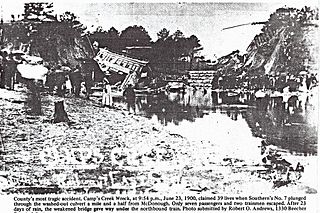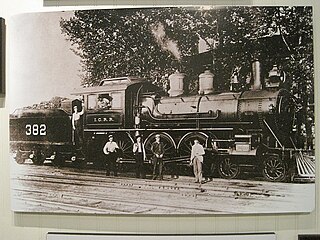Related Research Articles

John Luther "Casey" Jones was an American railroader who was killed when his passenger train collided with a stalled freight train in Vaughan, Mississippi.

A fireman, stoker or watertender is a person whose occupation it is to tend the fire for the running of a boiler, heating a building, or powering a steam engine. Much of the job is hard physical labor, such as shoveling fuel, typically coal, into the boiler's firebox. On steam locomotives the title fireman is usually used, while on steamships and stationary steam engines, such as those driving saw mills, the title is usually stoker. The German word Heizer is equivalent and in Dutch the word stoker is mostly used too. The United States Navy referred to them as watertenders.

The Wreck of the Old 97 was an American rail disaster involving the Southern Railway mail train, officially known as the Fast Mail, while en route from Monroe, Virginia, to Spencer, North Carolina, on September 27, 1903. Travelling at an excessive speed in an attempt to maintain schedule, the train derailed at the Stillhouse Trestle near Danville, Virginia, where it careened off the side of the bridge, killing 11 on-board personnel and injuring seven others. The wreck inspired a famous railroad ballad, which was the focus of a copyright lawsuit and became seminal in the genre of country music.

The 2-6-6-6 is an articulated locomotive type with two leading wheels, two sets of six driving wheels and six trailing wheels. Only two classes of the 2-6-6-6 type were built. One was the "Allegheny" class, built by the Lima Locomotive Works. The name comes from the locomotive's first service with the Chesapeake and Ohio Railway beginning in 1941, where it was used to haul loaded coal trains over the Allegheny Mountains. The other was the "Blue Ridge" class for the Virginian Railway. These were some of the most powerful reciprocating steam locomotives ever built, at 7,500 hp, and one of the heaviest at 386 tons for the locomotive itself plus 215 tons for the loaded tender.

A train driver is a person who operates a train, railcar, or other rail transport vehicle. The driver is in charge of and is responsible for the mechanical operation of the train, train speed, and all of the train handling. Train drivers must follow certain guidelines for driving a train safely.
"The Wreck of the Virginian" is an American folk song by Blind Alfred Reed recorded on July 28, 1927. The song describes a train wreck in Ingleside, West Virginia. The lyrics, which are essentially documentary, describe how, on "a bright Spring morning on the twenty-fourth of May," 1927, the engineer, E. G. Aldrich of Roanoke, Virginia, known as "Dad," and his fireman, Frank M. O'Neill of Pax, West Virginia, running train number three, "left Roanoke en route for Huntington." Then, "at eleven fifty-two that day, they just left Ingleside," when "an east-bound freight crushed into them." and they were both killed. The song also notes that "Dad" Aldritch had been an engineer on the line since 1906.
The Buffalo, Rochester, and Pittsburgh Railway was one of the more than ten thousand railroad companies founded in North America. It lasted much longer than most, serving communities from the shore of Lake Ontario to the center of western Pennsylvania.

The Purdue Wreck was a railroad train collision in Indianapolis, Indiana, on Saturday, October 31, 1903, between two special trains that killed 17 people, including 14 players of the 1903 Purdue University football team team. Team captain and future Indiana governor Harry G. Leslie was initially thought to have died in the accident, but was later revived.
The Fast Flying Virginian (FFV) was a named passenger train of the Chesapeake & Ohio Railway.
The Guyandotte River train wreck occurred on the morning of January 1, 1913, when the Chesapeake and Ohio Railway's (C&O) train No. 99, scheduled to run from Hinton, West Virginia, to Russell, Kentucky, and headed by Mikado locomotive 820, fell through a bridge over the Guyandotte River near Huntington, West Virginia while attempting to cross it. The accident killed seven people.

The Camp Creek train wreck was a railroad disaster that took place on 23 June 1900 just outside McDonough, Georgia. The northbound Southern Railway train hit a washout 1.5 miles north of the town, plunging 60 feet into the swollen creek below before bursting into flames, killing 35 of the 45 aboard the train.
On April 14, 1907, northbound freight train No.23 of the New York Central and Hudson River Railroad, operating on the Rome and Richland branch of the former Rome, Watertown and Ogdensburg Railroad crashed when the bank on the lower side of the track failed and a section slid down the hill undermining the track. The accident occurred approximately 2.5 miles south of Blossvale, a hamlet in the Oneida County, New York, town of Annsville. The sixty-car freight train, carrying coal and other freight was pulled by engines No. 1726 and 1863. Both engines plunged down the sixty foot embankment. The lead engine came to rest in an inverted position while the second engine was on its side. Both engines and several cars were destroyed by fire. In addition to the two engines, a total of fifteen cars derailed.

American Epic: The Best of The Carter Family is a compilation of Carter Family songs recorded between 1927 and 1933 and released in 2017 to accompany the award-winning American Epic documentary film series. The album was released as a 15-track download and a vinyl LP.
In 1890 a railway accident in Quincy, Massachusetts killed 23 people. It was the second major train wreck in the city, following the 1878 accident in Wollaston. The accident was caused by a jack that had been left on the track. The foreman of the crew that placed the jack on the track was charged with manslaughter, but the trial ended in a hung jury.

Illinois Central No. 382, also known as "Ole' 382" or "The Cannonball", was a 4-6-0 "Ten Wheeler" bought new from the Rogers Locomotive Works in Paterson, New Jersey for the Illinois Central Railroad. Constructed in 1898, the locomotive was used for fast passenger service between Chicago, Illinois and New Orleans, Louisiana. On the night of April 30, 1900, engineer Casey Jones and fireman Simeon "Sim" Webb were traveling with the engine from Memphis, Tennessee to Canton, Mississippi. The train collided into the rear of a freight train stuck on the mainline, killing Jones, and injuries dozens more in Vaughan, Mississippi, the last station before Canton. After the accident, the locomotive was rebuilt in Water Valley, Mississippi, and returned to service. The engine was believed to be cursed after Jones' death as it would suffer three more accidents in its career before being retired in July 1935, and scrapped.
References
- ↑ Lyle 1985, pp. 40–54.
- 1 2 Waltz, Robert B.; Engle, David G. (2021). "The Wreck on the C. & O." The Traditional Ballad Index: An Annotated Bibliography of the Folk Songs of the English-Speaking World. California State University, Fresno . Retrieved November 23, 2021.
- ↑ Cohen 2000, pp. 194–197.
- 1 2 3 Cox 1925, p. 221.
- ↑ "October 23, 1890: FFV Passenger Train Wrecks Three Miles East of Hinton". wvpublic.org. West Virginia Public Broadcasting. October 23, 2019. Archived from the original on November 23, 2021. Retrieved November 22, 2021.
- ↑ "Accident to the F.F.V.", Huntington Daily Advertiser, October 23, 1890, retrieved November 22, 2021
{{citation}}: CS1 maint: date and year (link) - ↑ Cohen 2000, pp. 188–189.
- ↑ Reneau, George; Austin, Gene (uncredited) (September 16, 1924). "The C & O Wreck". youtube.com. YouTube . Retrieved November 22, 2021.
- ↑ "October 23, 1890: "Wreck on the C&O"". West Virginia Department of Arts, Culture and History. Retrieved November 22, 2021.
- ↑ Cohen 2000, pp. 194–195.
- ↑ "Wreck on the C. & O." allmusic.com. AllMusic . Retrieved November 22, 2021.
- ↑ "Engine 143". allmusic.com. AllMusic . Retrieved November 22, 2021.
- ↑ "The F.F.V." allmusic.com. AllMusic . Retrieved November 22, 2021.
- ↑ Flippo, Chet (August 19, 2004). "Nashville Skyline: Carter Family Riches Recalled in The Unbroken Circle". cmt.com. Country Music Television . Retrieved November 22, 2021.
- ↑ Place, Jeff (2013). Dave Van Ronk: Down in Washington Square (PDF). The Smithsonian Folkways Collection. Washington, D.C.: Smithsonian Folkways. p. 23. Retrieved November 23, 2021.
- ↑ Waltz, Robert B.; Engle, David G. (2021). "The Wreck of the C & O Number Five". The Traditional Ballad Index: An Annotated Bibliography of the Folk Songs of the English-Speaking World. California State University, Fresno . Retrieved November 23, 2021.
- ↑ Delhart, Vernon (February 15, 1929). "The Wreck of the C&O No. 5". youtube.com. YouTube . Retrieved November 22, 2021.
- ↑ Cohen 2000, p. 189.
- 1 2 Cohen 2000, p. 193.
- ↑ "October 23, 1890: FFV Passenger Train Wrecks Three Miles East of Hinton". wvpublic.org. West Virginia Public Broadcasting. October 23, 2019. Archived from the original on November 23, 2021. Retrieved November 22, 2021.
- ↑ "Engine 143". genius.com. Genius. February 15, 1929. Retrieved November 22, 2021.
- ↑ Carter Family (February 15, 1929). "Engine 143". youtube.com. YouTube . Retrieved November 23, 2021.